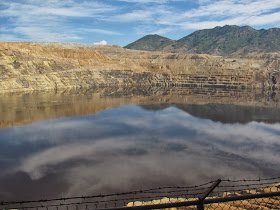 |
| You can see the mine shaft headframes in the midst of downtown Butte. |
 |
| These swings are one of kind and are over 100 years old. My guide on the tour bus remembers these from his childhood. |
 |
| Although most of the underground mines closed in the 1950s, above ground mining continued until 1983. Most of what you see continuing today is clean up of the toxic waste sites. |
 |
| More mine shaft headframes found in town. |
 |
| The trolley tour bus. |
 |
The Berkeley Pit opened in the 1950s and was mined until the 1980s. When the underground mines closed, much of the toxic wastewater flowed into the pit. |
 |
| The Dumas Hotel/Brothel. Opened in the late 1800s and operated until 1982. |
 |
The Mai Wah Museum shows the history of the Chinese immigrants to the area. |
 |
| Many of the homes reflect the money that once existed in this town, even though the homes have fallen into ruin. |
 |
| Some of the homes are being restored. |
 |
| Because of the many immigrants brought to Butte to mine, you find many styles of homes and architecture. |
 |
| A local mining museum has many pieces of equipment from the local mines. |
 |
Headframe of the original Butte mine, operating from 1878-1976. It was 3,569 feet deep. I wish I had had more time to explore this interesting city. Just one more place to return to. |






No comments:
Post a Comment